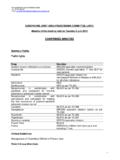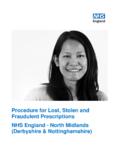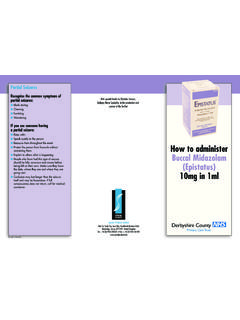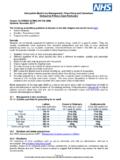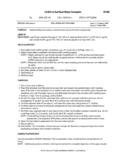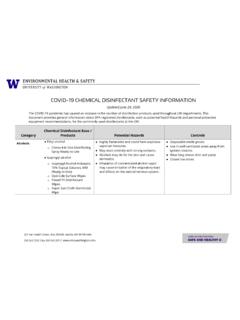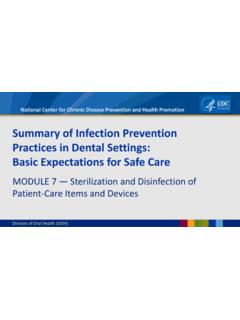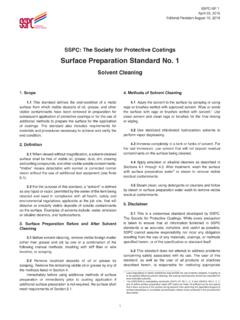Transcription of Oral thrush in babies and prescribing for surface and ...
1 Page 1 of 4 Reviewed: November 2019 Review Date: October 2022 prescribing for oral thrush in babies and prescribing for surface and ductal thrush in lactating women The recommendations made within this guidance are guided by expert reviews and best accepted practice. Miconazole oral gel use in children under 4 months is off-licence because of the risk of choking if not carefully applied. Care should be taken to ensure that the gel does not obstruct the throat in infants (avoiding application to the back of the throat and subdividing doses if necessary). Miconazole oral gel must not be applied to the nipple of a breastfeeding woman for administration to an infant, due to the risk of choking.
2 Miconazole oral gel for infants is the most effective product for oral thrush . Nystatin suspension is licenced for oral thrush , however, not as effective as miconazole in the treatment of infants with oral candida infection. In children fluconazole is extensively absorbed and has the potential for adverse effects. Its use in oral thrush is unnecessary for what is considered to be a minor illness Oral fluconazole is the most effective treatment for ductal thrush in lactating women of healthy term infants. Topical treatment with miconazole cream should also be given. To prevent re-infection, both mother and infant need to be treated simultaneously even if only one show symptoms of thrush .
3 DERBYSHIRE JOINT AREA prescribing COMMITTEE (JAPC) Page 2 of 4 Reviewed: November 2019 Review Date: October 2022 Introduction Breast feeding should be pain free and painful nipples are frequently reported as a reason women stop breastfeeding. The purpose of this guidance is to support the prescribing of treatments some of which is off-licence use in mothers, babies and infants. It is recommended the mother is referred to an appropriately trained person skilled in breastfeeding management to observe a breastfeed to ensure poor attachment is not causing the problem. thrush symptoms usually start suddenly affecting both breasts after the feed, severe pain lasting for about an hour.
4 thrush should not be diagnosed if pain is present only in one nipple/breast. Treat both the mother and the infant simultaneously: Oral thrush in baby treat baby for oral thrush + surface thrush in mother surface thrush in mother treat baby for oral thrush + surface thrush in mother Ductal thrush in mother +/- oral thrush in baby treat baby for oral thrush + ductal and surface thrush in mother Suspected oral thrush Signs and symptoms of thrush in an infant s mouth are: *Creamy white patches in the mouth, which do not rub off. Whitish sheen to saliva and inside of lips and gums (Mohrbacher & Stock 2003). Fussy at the breast attaches to the breast but continually comes off the breast.
5 Breast refusal. Colic symptoms: infants may be windy, fretful and find it hard to settle down (The Breastfeeding Network 2003a). Clicking sounds during feed (Hafner-Eaton 1997). Poor weight gain. Nappy rash. * note infants with a tongue tie are likely to have a white tongue as they are not able to throw the milk all the way to the back of the mouth Drug Dose Notes Miconazole oral gel Neonates *1ml in divided doses in the mouth 4 times a day Children 1month- 23 months * in divided doses in the mouth 4 times a day Children 2 years and above 4 times a day Miconazole oral gel is off-label when used in children younger than 4 months of age Use after feeds, smearing around the mouth.
6 The dose should be measured by oral syringe then administered by a clean fingertip. *To reduce the risk of choking the full dose should be divided into smaller portions The gel is to be applied with caution to all areas of the mouth, cheeks, gums, roof of mouth and the tongue with a clean fingertip to ensure that the gel does not obstruct the throat. Do not administer to young children with a spoon. The gel should not be applied to the back of the throat. Prescribe topical treatment for 7 days. If the infection has not resolved after 7 days, and there has been some response, extend the course of miconazole oral gel for a further week.
7 Advise the person to continue treatment for 7 days after symptoms resolve. Total course length may be up to 21 days. Page 3 of 4 Reviewed: November 2019 Review Date: October 2022 Suspected surface and ductal thrush Signs and symptoms in mother: Sudden onset of pain in both nipples after some days or weeks of pain-free breastfeeding. Nipples may be so painful the mother starts to dread feed times. The pain is not relieved by improved attachment. Cracked nipples, which do not heal. Nipples may be very sensitive to any touch and may be itchy. Loss of colour to the nipples or areola, or nipples may have a red, shiny appearance Mothers may have had a bout of vaginal thrush or taken a recent course of antibiotics.
8 The pain, often described as excruciating, stabbing, grazing, unbearable burning, and full of glass , occurs in both breasts after the feed due to baby transferring infection during breastfeeding. It starts at the end of the feed and can last about one hour after the feed. The symptoms are the same at every feed. Breast pain before feeds and or during the night is likely to result from over distended milk ducts when breasts are not being emptied properly. If the mother has ductal thrush the mother requires oral and topical treatment Drug Indication Dose Notes Fluconazole Oral treatment for ductal thrush 150mg 300mg as a single loading dose, then 50mg 100mgs twice daily for 10 days Off-licence use Larger doses for severe or prolonged symptoms Miconazole 2% topical cream surface thrush Apply a small amount to nipples after every feed Continue miconazole 2% cream treatment for 14 days even if symptoms resolve.
9 Note- the corticosteroid should be stopped as soon as the eczema has cleared Off-licence use Gently wipe off any cream which can be seen before next feed (no need to wash off) Miconazole 2% with Hydrocortisone 1% topical cream (for very red and inflamed nipples) Other related conditions Fusidic Acid 2% topical cream/ointment Bacterial infection Apply after each breastfeed for 5-7 days Nipple fissure is significantly associated with staphylococcus aureus infection. Use with topical antifungal treatment. Flucloxacillin (Erythromycin 500 mg four times a day to women who are allergic to penicillin) For bacterial infection 500 mg four times a day for 14 days If severe bacterial infection suspected (for example because of purulent exudate or crusts on the nipple) Hydrocortisone 1% cream or ointment (low potency) Mild eczema Apply sparingly twice daily immediately after each breastfeed Stop the corticosteroid as soon as the eczema has cleared.
10 Off-licence Gently wipe off any cream which can be seen before next feed (no need to wash off) Clobetasone butyrate ointment or cream for moderate to severe eczema (moderate potency) Moderate to severe eczema Apply sparingly Stop the corticosteroid as soon as the eczema has cleared. Off-licence Use for 3-5 days only followed by low potency steroid. If the eczema is unilateral and does not respond to treatment, suspect Paget's disease of the nipple and refer urgently (within 2 weeks). Pain relief can be managed by paracetamol or ibuprofen tablets. These are available to buy over the counter at supermarkets or pharmacies. Notes 1. Swabs of the mother s nipples and the baby s mouth are useful to confirm the presence/absence of fungal or bacterial infection (commonly Staph.)
